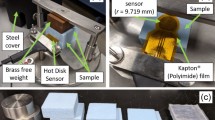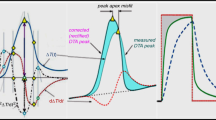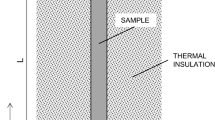Abstract
The paper presents an analysis of the experimental parameters involved in application of the dual-probe heat pulse technique, followed by a critical review of methods for processing thermal response data (e.g., maximum detection and nonlinear least square regression) and the consequent obtainable uncertainty. Glycerol was selected as testing liquid, and its thermal diffusivity was evaluated over the temperature range from − 20 °C to 60 °C. In addition, Monte Carlo simulation was used to assess the uncertainty propagation for maximum detection. It was concluded that maximum detection approach to process thermal response data gives the closest results to the reference data inasmuch nonlinear regression results are affected by major uncertainties due to partial correlation between the evaluated parameters. Besides, the interpolation of temperature data with a polynomial to find the maximum leads to a systematic difference between measured and reference data, as put into evidence by the Monte Carlo simulations; through its correction, this systematic error can be reduced to a negligible value, about 0.8 %.














Similar content being viewed by others
Abbreviations
- c p :
-
Specific heat (J·kg−1·K−1)
- d :
-
Probe or wire diameter (m)
- h :
-
Convection heat transfer coefficient (W·m−2·K−1)
- I :
-
Current (A)
- l :
-
Probe or wire length (m)
- \( \dot{q} \) :
-
Thermal power per unit length (W·m−1)
- r :
-
Distance between heater and temperature sensor (m)
- R :
-
Electric resistance (Ω)
- s :
-
Standard uncertainty (measured)
- S :
-
Wire section (m2)
- T :
-
Temperature (K) or (°C)
- α :
-
Thermal diffusivity (m2·s−1)
- δ :
-
Density (kg·m−3)
- λ :
-
Thermal conductivity (W·m−1·K−1)
- ρ :
-
Electric resistivity (Ω·m)
- σ :
-
Standard uncertainty (theoretical)
- τ :
-
Time (s)
- τ 0 :
-
Time pulse length (s)
- τ max :
-
Time at which the recorded temperature reaches its maximum value ΔTmax (s)
- ΔT :
-
Temperature increase (K) or (°C)
- ΔT max :
-
Maximum temperature increase (K) or (°C)
- ΔV :
-
Voltage increase (V)
- Δτ:
-
Time range in MD
- δτ :
-
Sampling frequency
- const :
-
Constantana
- w :
-
Wire
- CJ:
-
Thermocouple cold junction
- DAS:
-
Data acquisition system
- DAC:
-
Digital to analog converter
- DPHP:
-
Dual-probe heat pulse
- DAS:
-
Data acquisition system
- DAC:
-
Digital to analog converter
- MCS:
-
Monte Carlo simulation
- MD:
-
Maximum detection
- NL-LSF:
-
Nonlinear least square fitting
- PC:
-
Personal computer
- PS:
-
Power supply
- SR:
-
Shunt resistance
- s.u.:
-
Standard uncertainty
- TC:
-
Test chamber
- TCP:
-
Thermal conductivity probe
- TS:
-
Thermostat
References
Y. Nagasaka, A. Nagashima, Simultaneous measurement of the thermal conductivity and the thermal diffusivity of liquids by the transient hotwire method. Rev. Sci. Instrum. 52, 229–232 (1981). https://doi.org/10.1063/1.1136577
M.C.V. Ramires, C.A. Nieto de Castro, R.A. Perkins, Y. Nagasaka, A. Nagashima, M.J. Assael, W.A. Wakhem, Reference data for the thermal conductivity of saturated liquid toluene over a wide range of temperatures. J. Phys. Chem. Ref. Data 29, 133–139 (2000). https://doi.org/10.1063/1.556057
S. Alvarado, E. Marín, A.G. Juárez, A. Calderón, R. Ivanov, A hot-wire method based thermal conductivity measurement apparatus for teaching purposes. Eur. J. Phys. 33, 897–906 (2012). https://doi.org/10.1088/0143-0807/33/4/897
M.L. McCombie, V.R. Tarnawski, G. Bovesecchi, P. Coppa, W.H. Leong, Thermal conductivity of pyroclastic soil (pozzolana) from the environs of rome. Int. J. Thermophys. 38, 21 (2017). https://doi.org/10.1007/s10765-016-2161-y
G. Bovesecchi, P. Coppa, Basic problems in thermal-conductivity measurements of soils. Int. J. Thermophys. 34, 1962–1974 (2013). https://doi.org/10.1007/s10765-013-1503-2
P. Coppa, G. Bovesecchi, F. Fabrizi, Thermal conductivity and thermal linear expansion measurements on molten salts for assessing their behavior as heat transport fluids in thermodynamics solar systems, in Proceedings of the SPIE 7544, Sixth International Symposium on Precision Engineering Measurements and Instrumentation, (2010). https://doi.org/10.1117/12.886181
V.R. Tarnawski, T. Momose, W.H. Leong, G. Bovesecchi, P. Coppa, Thermal conductivity of standard sands. Part I. Dry-state conditions. Int. J. Thermophys. 30, 949–968 (2009). https://doi.org/10.1007/s10765-009-0596-0
G.S. Campbell, C. Calissendorff, J.H. Williams, Probe for measuring soil specific heat using heat-pulse method. Soil Sci. Soc. Am. J. 55, 291–293 (1990). https://doi.org/10.2136/sssaj1991.03615995005500010052x
K.L. Bristow, G.J. Kluitenberg, R. Horton, Measurement of soil thermal properties with a dual-probe heat-pulse technique. Soil Sci. Soc. Am. J. 58, 1288–1294 (1994). https://doi.org/10.2136/sssaj1994.03615995005800050002x
G.J. Kluitenberg, K.L. Bristow, B.S. Das, Error analysis of heat pulse method for measuring soil heat capacity, diffusivity, and conductivity. Soil Sci. Soc. Am. J. 59, 719–726 (1995). https://doi.org/10.2136/sssaj1995.03615995005900030013x
K.L. Bristow, J.R. Bilskie, G.J. Kluitenberg, R. Horton, Comparison of techniques for extracting soil thermal properties from dual-probe heat-pulse data. Soil Sci. 160, 1–7 (1995). https://doi.org/10.1097/00010694-199507000-00001
K.L. Bristow, G.J. Kluitenberg, C.J. Goding, T.S. Fitzgerald, A small multi-needle probe for measuring soil thermal properties, water content and electrical conductivity. Comput. Electron. Agric. 31, 265–280 (2001). https://doi.org/10.1016/S0168-1699(00)00186-1
S. Zhu, H.S. Ramaswamy, M. Marcotte, C. Chen, Y. Shao, A. Le Bail, evaluation of thermal properties of food materials at high pressures using a dual-needle line-heat-source method. J. Food Sci. 72, 49–56 (2007). https://doi.org/10.1111/j.1750-3841.2006.00243.x
A. Kadjo, J.-P. Garnier, J.P. Maye, S. Martemianov, A new transient two-wire method for measuring the thermal diffusivity of electrically conducting and highly corrosive liquids using small samples. Int. J. Thermophys. 29, 1267–1277 (2008). https://doi.org/10.1007/s10765-008-0472-3
S. Chudzik, Measuring system with a dual needle probe for testing the parameters of heat-insulating materials. Meas. Sci. Technol. 22, 1–10 (2011). https://doi.org/10.1088/0957-0233/22/7/075703
G. Liu, B.C. Si, Dual-probe heat pulse method for snow density and thermal properties measurement. Geophys. Res. Lett. 35, L16404 (2008). https://doi.org/10.1029/2008GL034897
D.J. Bremer, c. Agron. J. 95, 1625–1632 (2003). https://doi.org/10.2134/agronj2003.1625
T.E. Ochsner, R. Horton, T. Ren, Use of the dual-probe heat-pulse technique to monitor soil water content in the vadose zone. Vadose Zone J. 2, 572–579 (2003). https://doi.org/10.2113/2.4.572
N.H. Abu-Hamdeh, SW-soil and water: measurement of the thermal conductivity of sandy loam and clay loam soils using single and dual probes. J. Agric. Eng. Res. 80, 209–216 (2001). https://doi.org/10.1006/jaer.2001.0730
F. Gori, S. Corasaniti, The measurement of the thermal diffusivity to detect the amount of water in olivine, in The 14th International Symposium on Transport Phenomena, Bali, Indonesia, pp. 6–10, (2003). ISBN 979-97726-0-5
M.B. Yan Song, J.M. Kirkham, G.J. Ham, Kluitenberg dual probe heat pulse technique for measuring soil water content and sunflower water uptake. Soil Tillage Res. 50, 345–348 (1999). https://doi.org/10.1016/s0167-1987(99)00014-8
A. Valente, R. Morais, A. Tuli, J.W. Hopmans, G.J. Kluitenberg, Multi-functional probe for small-scale simultaneous measurements of soil thermal properties, water content, and electrical conductivity. Sens. Actuator A Phys. 132, 70–77 (2006). https://doi.org/10.1016/j.sna.2006.05.010
http://www.hukseflux.com/product/tns01?referrer=/product_group/thermal-conductivity. Accessed 23 May 2018
http://www.decagon.com/en/thermal/instruments/kd2-pro/. Accessed 23 May 2018
D. Maglic, R.E. Taylor, The Apparatus for Thermal Diffusivity Measurement by the Laser Pulse Method, Compendium of Thermophysical Property Measurement Methods (Plenum Press, New York, 1992). https://doi.org/10.1007/978-1-4615-3286-6_10
M. Potenza, A. Cataldo, G. Bovesecchi, S. Corasaniti, P. Coppa, S. Bellucci, Graphene nanoplatelets: thermal diffusivity and thermal conductivity by the flash method. AIP Adv. 7, 075214 (2017). https://doi.org/10.1063/1.4995513
G.F. Bocchini, G. Bovesecchi, P. Coppa, S. Corasaniti, R. Montanari, A. Varone, Thermal diffusivity of sintered steels with flash method at ambient temperature. Int. J. Thermophys. 37, 38 (2016). https://doi.org/10.1007/s10765-016-2050-4
H.S. Carslaw, J.C. Jaeger, Conduction of Heat in Solids (Oxford University Press, London, 1959). ISBN 0198533683
G.J. Kluitenberg, J.M. Ham, K.H. Bristow, Error analysis of the heat pulse method for measuring soil volumetric heat capacity. Soil Sci. Soc. Am. J. 57, 1444–1451 (1993). https://doi.org/10.2136/sssaj1993.03615995005700060008x
A.E. Wechsler, The probe method for measurement of thermal conductivity, in Compendium of Thermophysical Property Measurement Methods, pp. 161–185, (1992). https://doi.org/10.1007/978-1-4615-3286-6_6
C.P. Lentz, Thermal conductivity of meats, fats, gelatin gels and ice. Food Technol. 15, 243–247 (1961)
E.G. Murakami, V.E. Sweat, S.K. Sastry, E. Kolbe, K. Hayakawa, A. Datta, recommended design parameters for thermal conductivity probes for nonfrozen food materials. J. Food Eng. 27, 109–123 (1996). https://doi.org/10.1016/0260-8774(94)00088-3
E.G. Murakami, V.E. Sweat, S.K. Sastry, E. Kolbe, Analysis of various design and operating parameters of the thermal conductivity probe. J. Food Eng. 30, 209–225 (1996). https://doi.org/10.1016/S0260-8774(96)00010-6
P. Coppa, G. Pasquali, Thermal conductivity of lipidic emulsions and its use for production and quality control, in 2nd International Symposium on Instrumentation Science and Technology, Jinan, China, vol. 1, pp. 486–493 (2002)
S. Brandt, Statistical and Computational Methods in Data Analysis (North Holland Pub, Amsterdam, 1970)
E.R.G. Eckert, R.M. Drake, Heat and Mass Transfer, 2nd edn. (Mc Graw Hill, New York, 1959)
N.B. Vargaftik, L.P. Filippov, A.A. Tarzimanov, E.E. Totskii, Handbook of Thermal Conductivity of Liquids and Gases (CRC Press, Boca Raton, 1994)
ASTM C1616-05, Standard Test Method for Determining the Moisture Content of Inorganic Insulation Materials by Weight (ASTM International, West Conshohocken, PA, 2005). https://doi.org/10.1520/C1616-05
ISO/IEC Guide, Uncertainty of measurement—Part 3: Guide to the expression of uncertainty in measurement, 98-3 (2008). www.iso.org/standard/50461.html
Author information
Authors and Affiliations
Corresponding author
Appendix 1: Analytical Evaluation of the Temperature Increase in the Dual-Probe Method
Appendix 1: Analytical Evaluation of the Temperature Increase in the Dual-Probe Method
The solution of the conduction heat transfer equation of the “dual-probe” problem is obtained under the following assumptions:
-
pure radial heat conduction propagation;
-
homogeneous and isotropic medium;
-
infinite line heat source, verified by the length to diameter ratio greater than 50 [30];
-
square wave pulse with finite length.
Solution is obtained by overlapping two solutions, the first T1(τ) corresponding to the response of a material when a heat source in the shape of step function is applied to it; the second is another identical solution but shifted in time of a τ0 length and with negative value:
and
The analytical solution corresponding to the first input is obtained by the usual solution for the probe method, i.e.,
Being Ei the exponential integral:
The second solution is the same, shifted and with negative sign:
Thus, the same Eq. 8 is the solution of the “dual-probe” problem for \( 0 \le t \le \Delta \tau \), while the following:
for \( \tau_{0} \le \tau \le \infty \). This is the equation used as model for the nonlinear least square analysis (par. 3.2).
This equation presents a maximum, whose abscissa occurs after τ0 (i.e., as far as the heat is supplied, the temperature can only increase). The value of the maximum abscissa is calculated by deriving and equating the derivative to zero, i.e., being:
and
Thus,

where τmax is the time when the maximum occurs.
Rights and permissions
About this article
Cite this article
Bovesecchi, G., Coppa, P., Corasaniti, S. et al. Critical Analysis of Dual-Probe Heat-Pulse Technique Applied to Measuring Thermal Diffusivity. Int J Thermophys 39, 82 (2018). https://doi.org/10.1007/s10765-018-2402-3
Received:
Accepted:
Published:
DOI: https://doi.org/10.1007/s10765-018-2402-3




